Kuku FM, India’s largest audio platform, is leading the streaming industry with a phenomenal number of over 50 million active users and has already generated significant revenue through its unique dialectical content strategy. The audiobook market revenue is expected to reach approximately $9.84 billion by 2025 ( Medium ). The platform’s success story demonstrates a crucial market shift: consumers are increasingly gravitating toward regional, personalised audio content that resonates with their cultural preferences.
The fact that Kuku FM identified and capitalised on the untapped market of regional language content makes its journey quite interesting indeed. While global brands focused on English language entertainment, Kuku created an empire by providing content in Hindi, Tamil, Telugu, and other Indian languages. Entrepreneurs worldwide can use this positioning strategy as a blueprint to suit their local markets.
If you are thinking of getting into audio streaming, 2025 is the perfect year to do so. With people having less time on their hands, more smartphone users, and the acceptance of subscription-based entertainment gaining ground, the demand for personalised on-demand audio content continues to grow. This complete guide will walk you through everything about how to build an app like Kuku FM, from the actual concept to the technical implementation to the monetisation strategy.
What is Kuku FM & Why Build an App Like It?
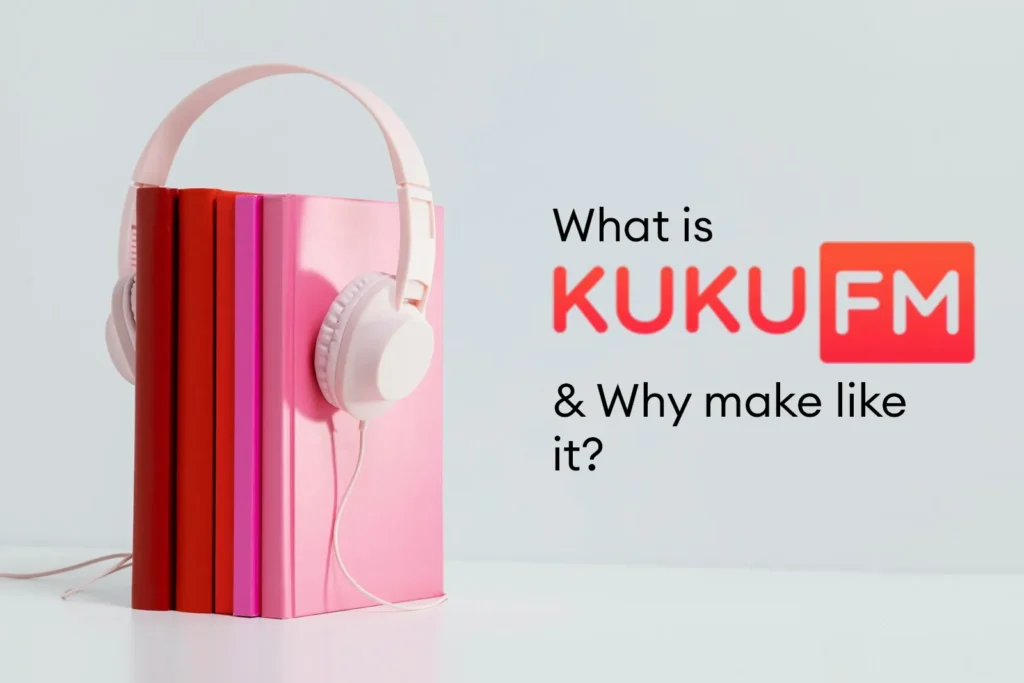
Kuku FM emerged as a game-changer in India’s digital content competition, launching with a clear vision to democratise audio content in regional languages. Founded in 2018, the platform began as a simple audio storytelling app but quickly evolved into a comprehensive ecosystem featuring audiobooks, podcasts, original series, and educational content. Kuku FM is unique in its laser focus on vernacular content, offering over 1,50,000 hours of audio content across multiple Indian languages.
The platform’s unique selling proposition lies in its deep understanding of India’s diverse linguistic concepts. While most international platforms struggled to create relevant content for Indian audiences, Kuku FM built relationships with local authors, storytellers, and content creators. This grassroots approach enabled them to offer authentic, culturally relevant content that resonated with millions of users across India’s developing and developed cities.
Kuku FM’s target audience primarily consists of working professionals aged 25-45 who prefer consuming content during commutes, busy parents seeking entertainment during household chores, and students looking for educational content in their native languages. The platform boasts impressive engagement metrics, with users spending an average of 45 minutes per session and maintaining a monthly retention rate of over 60% (GrowthX).
The market gap that Kuku FM identified was significant. India’s digital content consumption was predominantly English-centric, leaving hundreds of millions of vernacular speakers underserved. By positioning itself as the “Netflix of audio content for India,” Kuku FM tapped into this massive opportunity and created a sustainable competitive advantage.
Building a similar app in emerging markets presents tremendous opportunities. Countries across Southeast Asia, Latin America, and Africa have similar linguistic diversity and growing smartphone adoption rates. The key is identifying local content gaps and building authentic partnerships with regional creators. Success in this space requires understanding that audio content consumption patterns vary significantly across cultures, and one-size-fits-all approaches rarely work.
The rise of vernacular content demand isn’t limited to India. Global trends indicate that users increasingly prefer content in their native languages, creating opportunities for localised audio platforms worldwide. Markets like Indonesia, Brazil, and Nigeria show similar patterns of underserved vernacular audiences hungry for relevant content.
Essential Features for Audio Streaming Apps
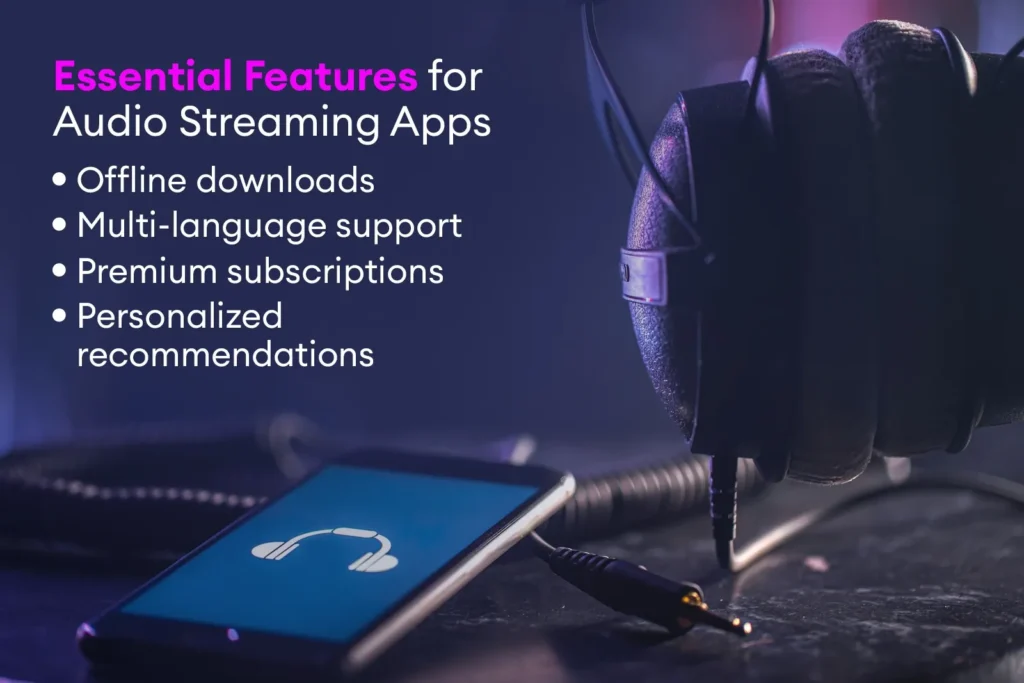
Creating a successful audio streaming app requires careful consideration of features that enhance user experience while supporting business objectives. The most critical features can make or break user adoption and long-term engagement.
Offline Downloads
Offline functionality represents one of the most valuable features for audio streaming apps, particularly in markets with inconsistent internet connectivity. Users with limited data plans or frequent travellers greatly appreciate the ability to download content for offline consumption. This feature significantly improves user retention, as listeners can maintain their consumption habits regardless of connectivity constraints.
From a technical perspective, implementing offline downloads requires robust backend support for content synchronisation, storage management, and digital rights management (DRM). The system must handle download queues, manage storage space efficiently, and ensure downloaded content remains secure from unauthorised distribution.
Multi-Language Support
Kuku FM’s success demonstrates the immense value of multi-language support in audio streaming apps. Regional language support goes beyond simple translation; it involves creating culturally relevant content catalogues, implementing language-specific search algorithms, and providing localised user interfaces.
Effective multi-language implementation requires understanding linguistic nuances, cultural preferences, and content consumption patterns specific to each language community. This includes supporting right-to-left text for languages like Arabic, implementing proper sorting algorithms for different scripts, and ensuring voice search functionality works across languages.
Premium Subscriptions
Subscription management forms the backbone of most successful audio streaming platforms. Premium subscriptions typically offer exclusive content access, ad-free listening experiences, unlimited downloads, and early access to new releases. The key lies in creating compelling premium offerings that justify the subscription cost.
Successful subscription implementation requires seamless in-app purchase flows, flexible subscription tiers (monthly, yearly, family plans), and robust payment gateway integration. The system should handle subscription renewals, cancellations, and promotional offers while maintaining detailed analytics on subscription performance.
Personalized Recommendations
AI-driven content recommendations significantly enhance user engagement by helping listeners discover relevant content. Effective recommendation systems analyse user behaviour, listening history, content preferences, and demographic information to suggest personalised content.
Modern recommendation engines employ collaborative filtering, content-based filtering, and hybrid approaches to deliver accurate suggestions. Machine learning algorithms continuously improve recommendations based on user feedback, listening completion rates, and engagement metrics.
Smart Search and Discovery
Advanced search functionality enables users to find content quickly using voice commands, text queries, or content categories. Smart search should support multiple languages, handle synonyms and colloquialisms, and provide instant results as users type.
Bookmarking and Playlist Creation
Personal content curation features like bookmarking and playlist creation increase user engagement and platform stickiness. Users should be able to create custom playlists, share them with friends, and organise content according to personal preferences.
Push Notifications
Strategic push notifications drive user re-engagement by alerting users about new content, subscription renewals, personalised recommendations, and special offers. However, notification strategies must be carefully balanced to avoid user annoyance.
User Reviews and Ratings
Community features like reviews and ratings help users discover quality content while providing valuable feedback to content creators. This social proof element significantly influences content consumption decisions.
Dark Mode and Accessibility
Modern apps must support dark mode for comfortable nighttime usage and implement accessibility features for users with disabilities. These seemingly minor features significantly impact user satisfaction and app store ratings.
Development Cost & Timeline for an Audio Streaming App
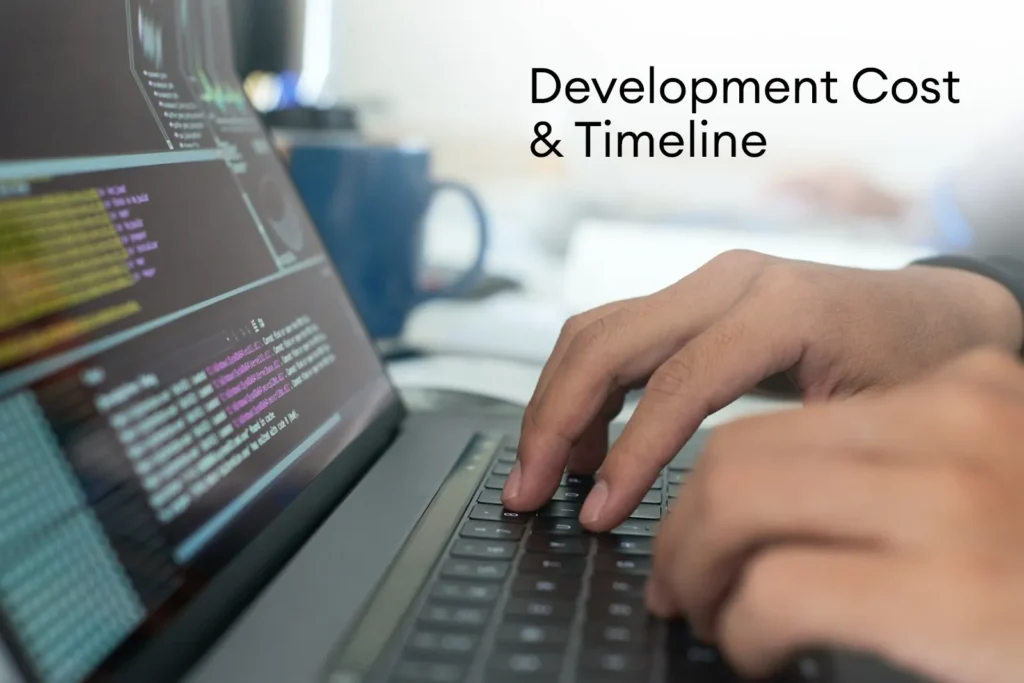
Understanding the financial investment and timeline required for audio streaming app development helps entrepreneurs make informed decisions and plan their resources effectively. Several factors influence the total development cost, making it essential to analyse each component carefully.
Development Cost Comparison by App Type
| App Type | Features Included | Cost Range (INR) | Timeline |
| Basic MVP | User registration, audio streaming, basic playlists, simple admin panel | ₹50,000 – ₹1,50,000 | 4-6 months |
| Standard App | MVP features + offline downloads, push notifications, social sharing, analytics | ₹1,50,000 – ₹3,00,000 | 6-8 months |
| Advanced App | Standard features + AI recommendations, multi-language, advanced CMS, payment integration | ₹3,00,000 – ₹5,00,000 | 8-10 months |
| Enterprise Solution | All features + white-label options, advanced analytics, scalable architecture, custom integrations | ₹5,00,000 – ₹7,00,000 | 10-15 months |
Development Team Rates by Region
| Region | Hourly Rate (INR) | Quality Level | Communication | Best For |
| North America | ₹8,000 – ₹16,000 | Premium | Excellent | Enterprise projects |
| Western Europe | ₹6,500 – ₹12,000 | High | Excellent | Mid to large projects |
| Eastern Europe | ₹4,000 – ₹8,000 | High | Good | Cost-effective quality |
| India (Colourmoon) | ₹2,000 – ₹4,000 | High | Excellent | Startups & enterprises |
| Southeast Asia | ₹1,500 – ₹3,200 | Variable | Good | Budget-conscious projects |
Development Approach Comparison
| Approach | Cost Impact (INR) | Timeline | Performance | Maintenance |
| Native (iOS + Android) | ₹4,00,000 – ₹7,00,000 | +40-50% | Excellent | High |
| Cross-Platform (Flutter) | ₹2,50,000 – ₹4,50,000 | Baseline | Very Good | Medium |
| Cross-Platform (React Native) | ₹2,00,000 – ₹4,00,000 | -10-15% | Good | Medium |
| Hybrid (Ionic/Cordova) | ₹1,50,000 – ₹3,00,000 | -20-30% | Fair | Low |
Detailed Development Phase Breakdown
| Phase | Duration | Percentage of Total Cost | Key Deliverables |
| Planning & Analysis | 3-4 weeks | 8-10% | Requirements document, technical specifications, project roadmap |
| UI/UX Design | 4-6 weeks | 20-25% | Wireframes, prototypes, design system, user flow |
| Frontend Development | 8-12 weeks | 30-35% | User interface, user experience, client-side functionality |
| Backend Development | 10-14 weeks | 25-30% | Server architecture, database, APIs, and admin panel |
| Quality Assurance | 4-6 weeks | 8-12% | Testing, bug fixes, performance optimisation |
| Deployment & Launch | 2-3 weeks | 5-8% | App store submission, server setup, and launch preparation |
Feature-Based Cost Breakdown
| Feature Category | Cost Range (INR) | Development Time | Complexity Level |
| Core Audio Streaming | ₹40,000 – ₹80,000 | 4-6 weeks | High |
| User Management | ₹25,000 – ₹50,000 | 2-3 weeks | Medium |
| Offline Downloads | ₹35,000 – ₹60,000 | 3-4 weeks | High |
| AI Recommendations | ₹60,000 – ₹1,20,000 | 5-7 weeks | Very High |
| Multi-language Support | ₹30,000 – ₹55,000 | 3-4 weeks | Medium |
| Payment Integration | ₹25,000 – ₹40,000 | 2-3 weeks | Medium |
| Analytics Dashboard | ₹45,000 – ₹75,000 | 4-5 weeks | High |
| Admin Panel | ₹35,000 – ₹65,000 | 3-4 weeks | Medium |
Ongoing Maintenance Costs
| Service Type | Monthly Cost (INR) | Annual Cost (INR) | Includes |
| Basic Maintenance | ₹15,000 – ₹30,000 | ₹1,80,000 – ₹3,60,000 | Bug fixes, minor updates, and server monitoring |
| Standard Support | ₹30,000 – ₹60,000 | ₹3,60,000 – ₹7,20,000 | Regular updates, feature enhancements, and 24/7 support |
| Premium Package | ₹60,000 – ₹1,20,000 | ₹7,20,000 – ₹14,40,000 | Continuous development, new features, and scaling support |
The choice between native and cross-platform development significantly impacts both cost and timeline. Native development for iOS and Android separately increases costs by 60-80% but provides optimal performance and platform-specific features. Cross-platform solutions using Flutter or React Native reduce costs by 30-40% while maintaining good performance across platforms.
The geographic location of the development team substantially affects costs. While North American teams charge premium rates, Indian development companies like Colourmoon Technologies offer competitive rates of ₹2,000-₹4,000 per hour while maintaining high-quality standards and excellent communication, making them ideal for both startups and enterprises.
Colourmoon Technologies offers flexible engagement models to accommodate different budget constraints and project requirements. Our custom pricing approach ensures startups receive cost-effective solutions while enterprises get comprehensive, scalable platforms that support their growth objectives.
Technical Requirements for Developing an App like KUKU FM
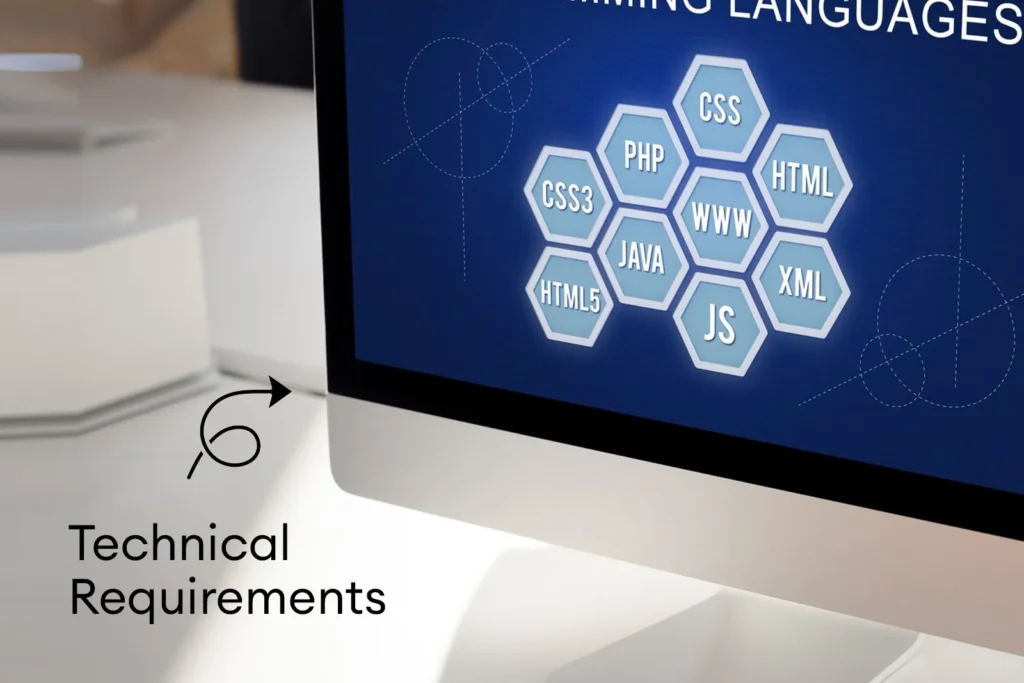
Building a robust audio streaming platform requires careful selection of technologies that ensure scalability, performance, and maintainability. The technical architecture forms the foundation that determines the app’s ability to handle growth and provide excellent user experiences.
1. Frontend Technologies: Flutter has emerged as the preferred choice for cross-platform audio app development, offering native performance with code reusability across iOS and Android platforms. Flutter’s rich widget ecosystem and excellent audio plugin support make it ideal for creating smooth, responsive audio streaming interfaces. React Native represents another viable option, particularly for teams with JavaScript expertise, though it may require additional optimisation for audio-intensive applications.
For teams prioritising platform-specific optimisation, native development using Swift for iOS and Kotlin for Android provides maximum performance and access to platform-exclusive features. This approach requires larger development teams but delivers superior user experiences, particularly for complex audio processing requirements.
2. Backend Architecture: Node.js with Express.js offers excellent performance for real-time audio streaming applications, providing efficient handling of concurrent connections and streaming protocols. Python with Django or FastAPI provides robust backend solutions with excellent machine learning integration capabilities, crucial for recommendation engines and content analysis.
Java Spring Boot remains a popular choice for enterprise-grade applications requiring high scalability and extensive third-party integrations. The choice depends on team expertise, scalability requirements, and integration needs with existing systems.
3. Audio Streaming Protocols: HTTP Live Streaming (HLS) has become the industry standard for audio streaming, providing adaptive bitrate streaming that adjusts quality based on network conditions. HLS ensures smooth playback across various devices and network conditions while supporting features like seek functionality and chapter navigation.
Dynamic Adaptive Streaming over HTTP (DASH) offers similar capabilities with broader industry support, though HLS remains more popular for audio-focused applications. Real-Time Messaging Protocol (RTMP) serves specific use cases for live audio streaming but requires a more complex implementation.
4. Cloud Infrastructure and Storage: Amazon Web Services (AWS) provides comprehensive cloud solutions for audio streaming platforms, including S3 for content storage, CloudFront for content delivery, and Elastic Compute Cloud (EC2) for scalable server infrastructure. AWS also offers specialised services like Amazon Transcribe for speech-to-text functionality and Amazon Polly for text-to-speech conversion.
Google Cloud Platform offers competitive alternatives with excellent machine learning integration through Google Cloud AI services. Firebase provides rapid development capabilities with real-time database functionality, though it may require additional services for large-scale audio storage and streaming.
5. Database Solutions: PostgreSQL offers robust relational database capabilities ideal for user management, content metadata, and complex queries required for recommendation engines. MongoDB provides flexible document-based storage suitable for content management and user preference data.
Redis serves as an excellent caching solution, improving response times for frequently accessed data like user playlists and recommendation results. For real-time features like live chat or social interactions, Firebase Realtime Database or Socket.io integration provides efficient solutions.
6. Authentication and Security: OAuth 2.0 integration with providers like Google, Facebook, and Apple provides seamless user registration while maintaining security standards. Firebase Authentication offers comprehensive user management with minimal implementation complexity.
Custom JWT (JSON Web Token) implementation provides flexibility for unique authentication requirements while maintaining security best practices. Implementing proper security measures, including data encryption, secure API endpoints, and content protection, ensures user trust and regulatory compliance.
7. Content Management System: A robust CMS (Content Management System) enables content creators and administrators to manage audio content efficiently. The system should support bulk uploads, metadata management, content categorisation, and scheduling capabilities. Integration with transcription services helps create searchable content and improves accessibility.
8. Content Delivery Network (CDN): CDN (Content Delivery Network) implementation ensures fast content delivery regardless of user location. CloudFlare, Amazon CloudFront, or Google Cloud CDN can significantly improve streaming performance and reduce server load.
9. Third-Party Integrations: Payment gateway integration with providers like Stripe, PayPal, or regional solutions ensures secure subscription management. Analytics integration with platforms like Google Analytics, Mixpanel, or custom solutions provides insights into user behaviour and content performance.
Social media integration enables content sharing and user acquisition through organic channels. Push notification services like Firebase Cloud Messaging or OneSignal support user engagement and retention strategies.
Monetisation Strategies of KUKU FM like Apps
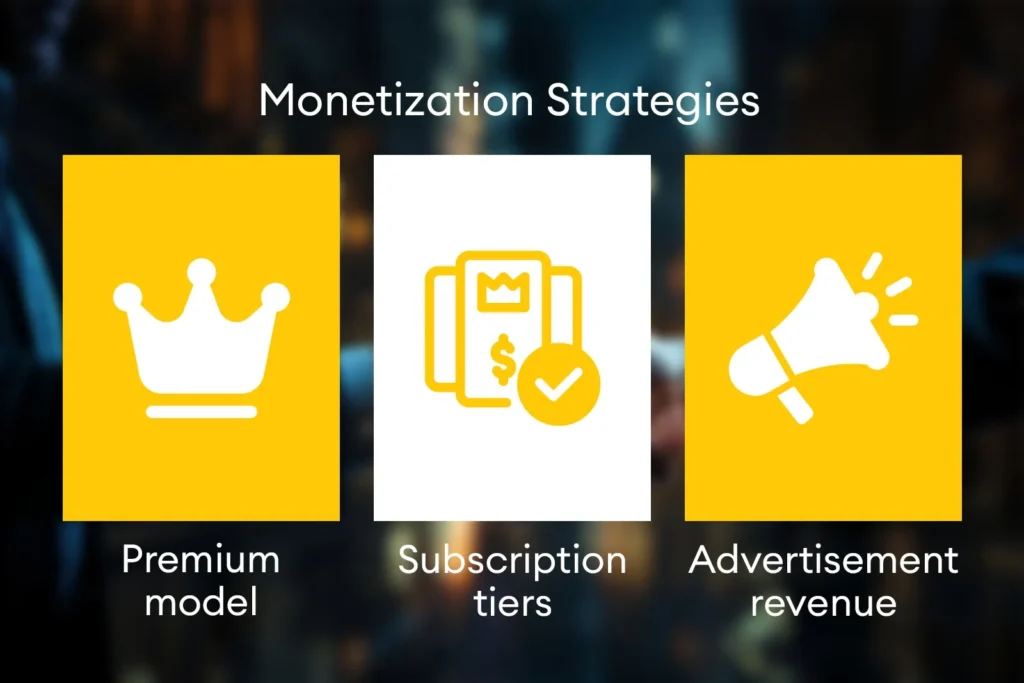
Developing sustainable revenue streams is crucial for long-term success in the competitive audio streaming market. Successful platforms typically employ multiple monetisation strategies to maximise revenue while maintaining user satisfaction.
1. Freemium Model Implementation
The freemium model has proven highly effective for audio streaming platforms, allowing users to experience core functionality while incentivising premium upgrades. Kuku FM’s success demonstrates the power of strategic content gating, where premium subscribers access exclusive content, ad-free experiences, and advanced features.
Effective freemium implementation requires a careful balance between free and premium offerings. Free users should receive sufficient value to remain engaged, while premium benefits must be compelling enough to justify subscription costs.
Content-gating strategies should focus on premium exclusives rather than restricting basic functionality. Popular approaches include early access to new releases, exclusive series, extended content libraries, and enhanced audio quality. This approach maintains user satisfaction while creating clear value propositions for premium subscriptions.
2. Subscription Tier Strategies
Multiple subscription tiers cater to diverse user preferences and spending capabilities. Basic premium tiers typically offer ad-free listening and unlimited skips, while higher tiers include offline downloads, exclusive content, and family sharing options.
Regional pricing strategies prove essential in emerging markets where purchasing power varies significantly. Student discounts, annual subscription discounts, and promotional pricing help attract price-sensitive users while maintaining revenue growth.
Family and group subscription options increase average revenue per user (ARPU) while reducing churn rates. Users are less likely to cancel subscriptions that affect multiple family members, improving long-term retention metrics.
3. Advertisement Revenue Optimisation
Audio advertising presents unique opportunities for targeted, engaging ad experiences that don’t interrupt visual content consumption. Pre-roll, mid-roll, and post-roll audio advertisements can generate substantial revenue when properly implemented and targeted.
Dynamic ad insertion technology enables real-time ad placement based on user demographics, listening history, and contextual relevance. This personalisation significantly improves ad effectiveness and advertiser satisfaction, leading to higher CPM rates.
Sponsored content and branded audio series provide premium advertising opportunities that integrate naturally with platform content. These partnerships often command higher rates while providing value to users through high-quality, entertaining content.
Banner and display advertisements within the app interface provide additional revenue streams without interrupting audio consumption. However, these must be carefully designed to avoid disrupting user experience or appearing overly intrusive.
4. Performance Marketing and Affiliate Revenue
Affiliate partnerships with audiobook publishers, educational platforms, and related services create additional revenue opportunities. Recommending relevant products and services to users generates commission income while providing value through curated suggestions.
5. Premium Content Partnerships
Exclusive content partnerships with popular creators, authors, and celebrities attract subscribers while creating unique value propositions. These partnerships often involve revenue-sharing arrangements that benefit both the platform and content creators.
6. Data Monetisation (Privacy-Compliant)
Aggregated, anonymised user insights provide valuable market research data for content creators, advertisers, and industry partners. This information helps improve content strategies and advertising effectiveness while generating additional revenue streams.
However, data monetisation must strictly adhere to privacy regulations like GDPR and maintain user trust through transparent data practices and opt-in consent mechanisms.
Ready to Build Your Audio App Like Kuku FM? Contact Us
Transforming your audio streaming app vision into reality requires partnering with experienced developers who understand both technical complexities and market dynamics. Colourmoon Technologies brings over a decade of expertise in mobile app development, with specialised experience in audio streaming platforms and content management systems.
Our comprehensive development approach ensures your app meets the highest standards of performance, scalability, and user experience. We’ve successfully delivered audio streaming solutions for clients across diverse markets, helping them achieve their business objectives while building engaged user communities.
Colourmoon Technologies is your go-to Partner
Our team combines technical excellence with deep market insights, enabling us to build apps that not only function flawlessly but also succeed in competitive markets. We understand the unique challenges of audio streaming platforms, from content delivery optimisation to user engagement strategies.
Our portfolio includes successful audio and video streaming applications that have achieved significant user adoption and revenue growth. We bring this experience to every project, helping clients avoid common pitfalls while implementing best practices that drive success.
We offer flexible engagement models suitable for startups, growing businesses, and established enterprises. Whether you need a complete development team or specific expertise to augment your existing team, we provide solutions that fit your budget and timeline requirements.
Our Long-Term Support and Growth
Our relationship doesn’t end at app launch. We provide ongoing maintenance, feature updates, and scaling support to help your platform grow. Our team monitors app performance, user feedback, and market trends to recommend improvements that drive user engagement and revenue growth.
We also offer marketing consultation and ASO (App Store Optimisation) services to help your app achieve visibility and attract users in competitive app stores.
Get Started Today
Ready to join the audio streaming revolution? Contact Colourmoon Technologies today for a free consultation where we’ll discuss your vision, analyse market opportunities, and provide detailed project proposals tailored to your specific requirements.
Reach out to us or schedule a discovery call to explore how we can help transform your audio streaming app idea into a successful, profitable platform that delights users and achieves your business objectives.
Conclusion
The audio streaming industry in 2025 presents unprecedented opportunities for entrepreneurs willing to understand and serve underserved market segments. Kuku FM’s success demonstrates that focusing on regional content and cultural relevance can create sustainable competitive advantages in seemingly saturated markets.
Building a successful audio streaming app requires understanding your target audience, implementing essential features, choosing appropriate technology stacks, and developing diverse monetisation strategies that balance user satisfaction with revenue growth. The rise of vernacular content consumption and increasing smartphone penetration create perfect opportunities for new platforms.
At Colourmoon Technologies, we’re excited to help ambitious entrepreneurs capitalise on these opportunities. Our comprehensive expertise in mobile app development, combined with a deep understanding of audio streaming platforms, positions us perfectly to help turn your vision into the next big success story.
Let’s turn your app idea into the next big thing in audio streaming. Contact us today to begin your journey toward building a successful, profitable audio streaming platform.
How much does it cost to develop an app like Kuku FM?
The cost of developing an audio streaming app like Kuku FM varies significantly based on features, complexity, and development team location.
A basic MVP typically costs ₹50,000 – ₹1,50,000, while a full-featured app with advanced capabilities like AI recommendations, offline downloads, and multi-language support ranges from ₹5,00,000 – ₹7,00,000.
Factors affecting cost include the number of platforms (iOS, Android, web), backend complexity, third-party integrations, and ongoing maintenance requirements. At Colourmoon Technologies, we provide detailed cost estimates after analysing your specific requirements and offer flexible payment structures to accommodate different budget constraints.
What are the key features needed in an audio streaming app?
Essential features for a successful audio streaming app include user registration and profile management, high-quality audio streaming with multiple bitrate options, offline download capabilities, personalised recommendations, multi-language support, subscription management, push notifications, social sharing, and comprehensive search functionality. Advanced features that enhance user engagement include custom playlists, bookmarking, sleep timers, speed controls, and community features like reviews and ratings. The specific feature set should align with your target audience’s needs and business model objectives.
How long does it take to build an audio streaming app?
The development timeline depends on app complexity and team size. An MVP with core features typically requires 4-6 months, including planning, design, development, and testing phases. A comprehensive app with advanced features like AI recommendations, extensive admin panels, and multiple platform support takes 8-12 months. The timeline includes requirement analysis (3-4 weeks), UI/UX design (4-6 weeks), frontend development (8-12 weeks), backend development (10-14 weeks), quality assurance (4-6 weeks), and deployment preparation (2-3 weeks). Colourmoon Technologies uses agile methodology to ensure efficient development while maintaining flexibility for requirement changes throughout the process.
What is the business model of Kuku FM?
Kuku FM operates on a freemium business model that combines subscription revenue with strategic advertising. The platform offers free access to a limited content library with advertisements, while premium subscribers enjoy unlimited access to exclusive content, ad-free listening, offline downloads, and early access to new releases. Their subscription tiers include monthly and yearly plans with different pricing strategies for various markets. Additionally, Kuku FM generates revenue through partnerships with content creators, sponsored content, and affiliate marketing. The company also explores B2B opportunities by licensing content to other platforms and offering white-label solutions. This diversified approach has enabled Kuku FM to achieve sustainable growth while maintaining user engagement across different demographic segments.



